Cutting the military's tuitions assistance program will hurt recruitment and retention rates if allowed to continue through 2014 and beyond, service personnel chiefs warned Wednesday.
The troops "need the assistance to advance their careers," and failure to restore the funding "could damage recruitment and retention for many years to come," said Lt. Gen. Howard Bromberg, the Army's deputy chief of Staff for Personnel.
Other service personnel chiefs echoed Bromberg at a hearing of the Military Personnel Subcommittee of the House Armed Services Committee on the impact of the budget cuts mandated by the Congressional sequestration process on military families.
The Army, Air Force, Marine Corps and Coast Guard have already announced the suspension of new enrollments for tuition assistance and advised those currently enrolled that they will have to find other sources of funding for future courses.
The Navy has yet to act on tuition assistance, and Pentagon sources said that Adm. Jonathan Greenert, the chief of Naval Operations, was pushing to save at least part of the program. Jessica Wright, the acting undersecretary of Defense for Personnel and Readiness, has reviewed Greenert's proposal to keep tuition assistance for the Navy at 75 percent of current levels.
George Little, the chief Pentagon spokesman, said Tuesday the services would not choose to suspend the tuition assistance program if not for sequestration – legislation found in the Budget Control Act that has forced the military to cut $46 billion from its budget by Oct. 1.
"None of us like to make tough choices with respect to tuition assistance. We're here because of sequestration. The tuition assistance program is important to our department and our service members," he said. "These are tough choices for the services," Little said Tuesday.
At the hearing, Vice Adm. Scott R. Van Buskirk, the deputy chief of Naval Operations for Manpower, Personnel , Training and Education, said that the Navy currently has about 45,000 sailors receiving tuition assistance annually at a cost of about $84 million.
The suspension of new enrollments for tuition assistance, which now provides about $250 per credit hour and up to $4,500 annually, "will have an immediate and long-term impact" on recruitment, said Air Force Lt. Gen. Darrell T. Jones, the deputy chief of Staff for Manpower, Personnel and Services.
"This action will impact our ability to harness the full potential of our airmen," Jones said. "I'm concerned we're sending them the wrong signal" about their worth to the Air Force, Jones said.
Recruiting has operated at a record pace in recent years. Services have routinely met and exceeded their monthly quotas with recruiters attributing tuition assistance and the new GI Bill for those who leave the service as main factors in influencing young men and women to join the military.
Marine Lt. Gen. Robert E. Milstead, the deputy Commandant for Manpower and Reserve Affairs, said the advertising budget for recruiting would also be cut because of sequestration.
"Our recruiters are already working 60-hour weeks," Milstead said, and the suspension of new enrollments for tuition assistance "is just going to put an additional burden on them."
However, as the U.S. military ends a decade-long period in which it fought two wars in Iraq and Afghanistan, there are those who will question if the military will need to spend as much on recruiting as the size of each service shrinks.
Service chiefs anticipate that a natural attrition will occur as the military brings fewer recruits into the service thus requiring the military to force out fewer active duty servicemembers.



























